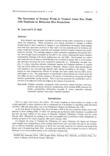The Succession of Noxious Weeds in Tropical Asian Rice Fields with Emphasis on Malaysian Rice Ecosystems
JIRCAS international symposium series
| ISSN | 13406108 |
|---|---|
| NII recode ID (NCID) | AA1100908X |

Full text
intlsymp-4_11-26.pdf617.2 KB
Both allogenic and autogenic successions occurred among weed communities in tropical Asian rice ecosystems. These successions were largely attributed to changes in habitat brought about by and in response to changes in crop establishment techniques, weed management and other agronomic practices of what used to be low pesticide and low fertilizer sedentary traditional farming to pesticide and inorganic fertilizer-oriented irrigated and mechanized rice farming. The resulting changes in weed community populations and species diversity were brought about principally by the shift in rice culture replacing the labour-intensive transplanting technique with direct seeding since the mid-1980s. Direct-seeded rice culture and continuous use of phenoxy herbicides then have resulted in species shift in weed community structure favouring the more competitive graminoids, viz. Echinochloa crus-galli complex,E. colona, Leptochloa chinensis, Ischaemum rugosum and Paspalum distichum in tropical Asia and of late weedy rice (Oryza sativa) in Malaysia. Being C4 plants, these graminoids are well adapted to hot, arid and high intensity light regimes prevailing in the tropics. These species are also comparatively efficient in nitrogen and water uptake and can inflict severe yield losses on rice. The predominance of graminoids in direct-seeded rice culture since the mid-1980s, has led to inevitable changes in the pattern of herbicide use favouring the highly selective graminicides among farmers. This in turn has promoted the proliferation and recurrence of broadleaved weeds and sedges at the expense of graminoids.
| Creator | M. Azmi B. B. Baki |
|---|---|
| Subject | allogenic autogenic successions weed community species diversity weed management agronomic practices transplanting direct seeding (DSR) phenoxy herbicides graminicides Echinochloa crus-galli E. colona Leptochloa chinensis Ischaemum rugosum Oryza sativa Paspalum distichum |
| Publisher | Japan International Research Center for Agricultural Sciences |
| Available Online | |
| Issue | 4 |
| spage | 11 |
| epage | 26 |
| Language | eng |
